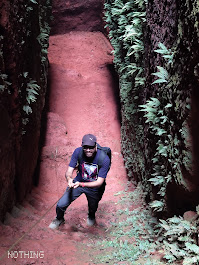Kamalgad Fort: Exploring the Rugged Beauty
Introduction:
Nestled in the lush green forests of the Sahyadri mountain range, Kamalgad Fort is a hidden gem for avid trekkers and history enthusiasts alike. Built in the 16th century, this fort offers spectacular views and an immersive experience into the rich cultural history of the Marathas.
In this blog, I take you through a comprehensive guide to trekking to Kamalgad Fort, giving details about the trail, the architecture and structures inside the fort, the surrounding landscape, and tips for travelers. Whether you're a beginner looking for an easy trek or an experienced trekker seeking offbeat destinations, the trek to Kamalgad Fort is sure to delight. So read on as I transport you through the rugged forests and help you uncover the raw, rustic beauty of Kamalgad.
Overview of Kamalgad Fort:
Kamalgad, also known as Bhelanja, is a small hill fort nestled in the rugged Sahyadri ranges near Wai in Maharashtra. Perched at an elevation of about 4800 ft above sea level, the fort is believed to have been built during the Bahamani rule and later came under the Adil Shahi dynasty of Bijapur. Shivaji Maharaj won the fort in 1657 and it played a strategic role for the Marathas over the next century due to its location overlooking trade routes. The fort is surrounded by dense forests and has dilapidated structures like the main entrance, idols and cisterns that provide a glimpse into its grand past. The challenging climb and the breathtaking views make Kamalgad a great offbeat destination for trekkers.
Getting There:
Kamalgad is about 60 km from Satara and 116 km from Pune in Maharashtra. The base village for the trek is Ambavne, located about 10 km from Wai.
By Road: There are regular buses
plying from Pune and Satara to Wai town. Ambavne is accessible by bus or
private taxi from Wai. Hiring a private cab from Pune is another convenient
option for a more comfortable journey.
Once you reach Ambavne, you can either hire local jeeps or
trek the 2 km route on foot to the base of the hill from where the 1.5 hour
climb starts. Ensure you start early to avoid afternoon heat.
The Trek and Fort Features:
The trek begins from the base where the path is initially well-defined and passes through thick forests with trees like Sandalwood and Ebony. After about a 30 minutes climb, you reach the entrance which has two tents carved from the rock. The path gets steeper from here with some rock cut steps guiding you. There are no railings so be cautious with your steps.
In 15-20 minutes you reach the main entrance to the plateau which has ruins of a Mahadarwaja indicating it was an important fort. The arched entrance has ornate carvings of flowers and dancing women bearing testament to the excellent workmanship of the period.
Once you enter the main fort area, the first structure you see is the Mahadev temple built in black stone rising towering above the other ruins. The sanctum enshrines a beautiful Shivlinga decorated with carved Nandi figures on the side. The temple has an east-facing doorway flanked by intact pillars.
Just beside the temple are cisterns carved from rock that once stored fort's water supply named ‘Kavechi Vihir’. Descending south from here you can see remnants of living quarters for soldiers, granaries and stables indicating Kamalgad's strategic importance.
A short walk from here leads you to the cliff from where you get a bird's-eye view of the lush green forests and valleys below. You can see the meandering Krishna River and surrounding hills from this vantage point. Sit a while to soak in the gorgeous panoramic views as you feel refreshed by the cool mountain air.
Make your way back to the Mahadev temple to see other ruins like the Satamahan burial places. Some dilapidated walls, arches and entrance ways can be seen scattered around the fort. There is also a rock-cut water cistern called Gangasagar on the west side.
The top of the fort is covered with dense overgrowth so be careful of snakes and thorny bushes when exploring.
Trekking Down and Other Tips:
For the descent, take the southern path from the fort entrance passing the stairway and caves to reach the base village. The entire trek takes about 4-5 hours so carry enough water and snacks.
November to February are the best months to plan your visit when the weather is pleasant. Summers can be very hot and humid.
Carry sturdy shoes, hat/caps, sunglasses and sunscreen to protect you from the blazing afternoon sun.
There are no facilities for staying on the fort so you have to plan your trip as a day excursion. The closest town for accommodation is Wai.
Though the trek is not very strenuous, first-timers may find it a little tricky due to the exposed climbing. Get a guide to accompany you for a smoother experience.
Look out for interesting flora like sandalwood trees and wildflowers on the way. And watch out for birds like quails, peacocks, langurs and mongooses.
While at the fort, be careful of the edges and keep children close by your side at all times.
So if you love offbeat treks combining scenic views with a slice of history, Kamalgad Fort should definitely feature high on your bucket list. The pleasant trek and rich heritage experience makes it a must-visit getaway from urban chaos.
Conclusion:
Kamalgad trek is the perfect monsoon trip combining beautiful nature views with historical sights. The fort may be in ruins but it still showcases splendid carvings and stonework. For adventure lovers looking to uncover the secrets of this area, Kamalgad offers an enchanting experience. The lush forests rejuvenate you with their pure air while the panoramas make all the effort worthwhile. So head out soon to enjoy this scenic slice of Sahyadri and let the old-world charm of Kamalgad Fort take you back in time.
Author- Pravin Jagtap, Pune


















Comments
Post a Comment